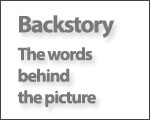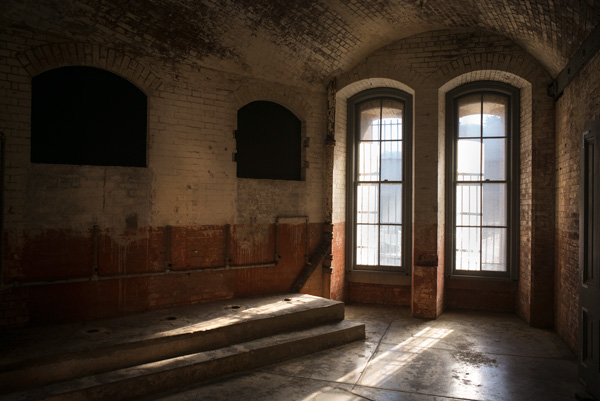A long time ago, when I first studied photography, I wandered the parks and other public spaces of San Francisco carrying a camera loaded with film looking for light and shape. I never made any memorable images, but I enjoyed the capture of the moment and solitude of the experience – and still do.
 One of my favorite locations – and that of many other would-be art photographers — was Fort Point. It was a wondrous, messy collage of brick walls, stone stairways and long hallways that bisected barracks whose wooden floors and plaster walls were in lovely decay. Light burst into the building through long, tall windows and slithered along the steps of the stairwells. The Fort was thinly staffed and the deep, dark cul-de-sacs of the gun mounts provided ample private space to photograph the texture of the weathered brick or, quite often, the alabaster curves of a girlfriend’s body.
One of my favorite locations – and that of many other would-be art photographers — was Fort Point. It was a wondrous, messy collage of brick walls, stone stairways and long hallways that bisected barracks whose wooden floors and plaster walls were in lovely decay. Light burst into the building through long, tall windows and slithered along the steps of the stairwells. The Fort was thinly staffed and the deep, dark cul-de-sacs of the gun mounts provided ample private space to photograph the texture of the weathered brick or, quite often, the alabaster curves of a girlfriend’s body.
Today, Fort Point is cleaned up. The barracks are refreshed and repaired and host orderly exhibits of past military life. Families hike the stairs and shoot selfies on the roof beneath the yawning maw of the Golden Gate Bridge. Everyone is fully dressed.
Nonetheless, I return when I can, as I did yesterday. After several days of sickness, which overlapped the chaos of Thanksgiving and the return from a difficult trip to Mexico, I sought shelter in the Fort while returning to Marin from SFO, where I had dropped off KT.
I put the new little camera in the bag and walked the along breakwater that connects Chrissy Field to the Fort. As I entered, I dropped a couple of bucks in donation box in the entryway – what a deal, I thought.
Out of the chill wind, I daubed the moisture that these days forms in my eyes from the cold, and saw, to my relief and pleasure, that nothing had changed since I was there about a year ago. The Park Service has managed to upgrade the interior and preserve the exterior. Nicely done. What persists is a sturdy physical link between my ever-lengthening past and my increasingly tenuous present.
Fort Point, like those other photographic haunts of my Kodak-fueled youth – Golden Gate Park, Telegraph Hill, Powell & Market – always ignites a complex set of feelings. With remembrance of innocence comes wistfulness. With recognition of the physical space comes comfort. With the arithmetic of time comes anxiety over the diminishing sum that remains. With the touch of the camera comes anticipation.
It is the latter, above all else, that brings me back to this space beneath the bridge – the physicality of the camera and the instantaneous sense of intimacy it engenders in me. As my right thumb finds its resting spot on the back of the camera, as I feel the weight of the German metal in my hand, as I adjust the lens with the fingers of my left hand and as I point the glass toward a wall or a stairs I’ve photographed many times before, I become lost in the viewfinder. The moment engulfs me and I yield, at last, to its comfort.
Odd, isn’t it, that such a feeling could persist with such strength for all of these years? It draws me back again and again, and I respond, knowing that in those times when I need to find myself I must go where I can lose myself.

